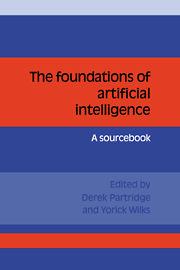Book contents
- Frontmatter
- Contents
- List of contributors
- Preface
- Acknowledgments
- 1 Introduction
- 2 The formal foundations of AI
- 3 Levels of theory
- 4 Programs and theories
- 5 The role of representations
- 6 The role of programs in AI
- 7 Rational reconstruction as an AI methodology
- 8 Is AI special in regard to its methodology?
- 9 Does connectionism provide a new paradigm for AI?
- Why there STILL has to be a language of thought
- Connectionism and the foundations of AI
- Some comments on Smolensky and Fodor
- Representation and high-speed computation in neural networks
- 10 The role of correctness in AI
- 11 Limitations on current AI technology
- 12 Annotated bibliography on the foundations of AI
- Index of names
Representation and high-speed computation in neural networks
Published online by Cambridge University Press: 03 May 2010
- Frontmatter
- Contents
- List of contributors
- Preface
- Acknowledgments
- 1 Introduction
- 2 The formal foundations of AI
- 3 Levels of theory
- 4 Programs and theories
- 5 The role of representations
- 6 The role of programs in AI
- 7 Rational reconstruction as an AI methodology
- 8 Is AI special in regard to its methodology?
- 9 Does connectionism provide a new paradigm for AI?
- Why there STILL has to be a language of thought
- Connectionism and the foundations of AI
- Some comments on Smolensky and Fodor
- Representation and high-speed computation in neural networks
- 10 The role of correctness in AI
- 11 Limitations on current AI technology
- 12 Annotated bibliography on the foundations of AI
- Index of names
Summary
Introduction
What I want to sell you is some neuroscience. I want to sell you the idea that current neuroscience has become directly relevant to the cognitive/computational issues that have always concerned AI. In what follows I shall outline a highly general scheme for representation and computation, a scheme inspired in part by the microarchitecture of both the cerebral and the cerebellar cortex. We shall also explore some of the interesting properties displayed by computing systems of this general kind.
The basic claim, to be explained as we proceed, is that the brain represents specific states of affairs by implementing specific positions in an appropriate state space, and it performs computations on such representations by means of general coordinate transformations from one state space to another. (There is no suggestion that this is the only mode of information-processing in the brain. But its role does seem to be nontrivial.)
That one can perform computations by this abstract means will be old news to some readers. For them, I hope to occasion surprise with evidence about the implementation of these procedures in the microanatomy of the empirical brain. Also intriguing is the natural way in which problems of sensorimotor coordination can be solved by this approach, since from an evolutionary point of view, sensorimotor coordination is where cognitive activity had its raw beginnings. Of further interest is the very great representational power of such systems, and the truly extraordinary speed with which even biological implementations of such procedures can perform computations of great complexity.
Information
- Type
- Chapter
- Information
- The Foundations of Artificial IntelligenceA Sourcebook, pp. 337 - 360Publisher: Cambridge University PressPrint publication year: 1990
Accessibility standard: Unknown
Why this information is here
This section outlines the accessibility features of this content - including support for screen readers, full keyboard navigation and high-contrast display options. This may not be relevant for you.Accessibility Information
- 2
- Cited by
